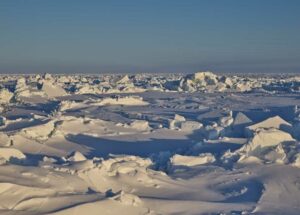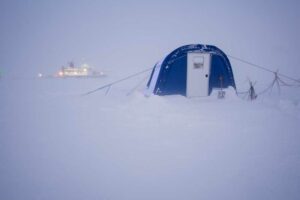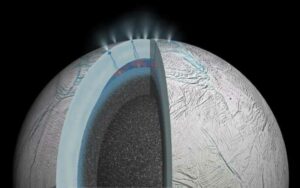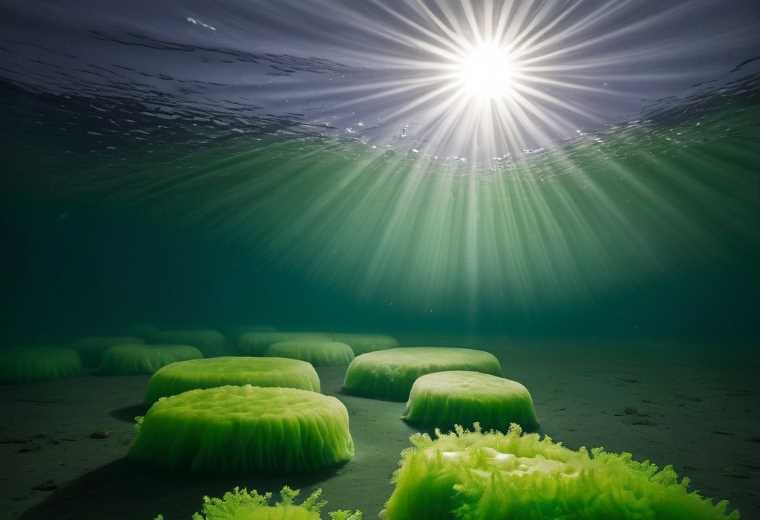An international team of scientists studying the development of Arctic algae deep beneath the snow and ice cover of the Arctic Ocean has found the lifeform was able to use an almost infinitesimal amount of sunlight to generate energy through photosynthesis. Part of the MOSAiC expedition at 88° northern latitude, the research effort found that algae begin to use photosynthesis to create biomass as soon as March, even at the end of the Arctic night when the sun is at its lowest point.
“It is very impressive to see how efficiently the algae can utilize such low amounts of light,” said research team leader and study co-author Clara Hoppe from the Alfred Wegener Institute, Helmholtz Centre for Polar and Marine Research (AWI). “This shows once again how well organisms are adapted to their environment.”


Photosynthesis at the Theoretical Limit
Before this discovery, scientists had more or less determined the minimum amount of light needed for chlorophyll-containing organisms to take advantage of photosynthesis. However, no living organism has even come close to reaching that minimum level.
To see if living ice algae and their counterpart phytoplankton could approach this theoretical limit, the researchers chose an environment that receives almost no light: the depths of the Arctic Ocean. Together, these two hardy organisms produce the majority of photosynthesis in the central Arctic.
To ensure they had data from all seasons and conditions, the researchers froze the German research icebreaker ship Polarstern in the central icepack of the Arctic Ocean for an entire year. They also chose to perform their analysis at the end of the polar night when the sun had yet to rise above the horizon.


To their surprise, the team found that only a few days after the end of the month-long polar night, the biomass of these two organisms had built up again. This proved that photosynthesis must be occurring, even underneath snow-covered sea ice, which only allows a scant few photons through. According to the extremely sensitive light sensors employed by the research team, the microalgae that had recovered the most “only had about one hundred thousandth of the amount of light of a sunny day on the Earth’s surface available for their growth.”
“To measure such low light levels under the harsh conditions of the Arctic winter, we had to freeze special, newly developed instruments into the ice in the middle of the polar night,” explained Sea ice researcher and team member Dr. Niels Fuchs.
Finding Increases Hopes for Life in the Oceans of Europa and Enceladus
There was a chance that some amount of unmeasured sunlight was making its way down to these lifeforms that the team missed. According to Prof Dirk Notz from the Institute of Marine Research at the University of Hamburg, who, along with Fuchs, performed the actual measurements, the irregularities in the light field under the ice due to variations in ice thickness and snow were definitely a concern, Still, Notz says, “in the end, we could be sure: There was just not more light.”
While the study focused on the terrestrial life forms found in the Arctic Sea, it could significantly impact future missions to search for life in the oceans of Titan’s moon, Enceladus, and Jupiter’s moon, Europa. These space bodies appear to have massive oceans of seawater underneath miles of ice on their surface.


Previous theoretical models have suggested that living organisms in the seas of these two moons might utilize the energy from deep-sea vents like some extremophiles found in the depths of Earth’s oceans. This finding may increase the possibility that life can survive in these remote environments if they receive even a tiny amount of sunlight.
“Even though our results are specific to the Arctic Ocean, they show what photosynthesis is capable of,” said Hoppe, “If it is so efficient under the challenging conditions of the Arctic, we can assume that organisms in other regions of the oceans have also adapted so well.”
The study “Photosynthetic light requirement near the theoretical minimum detected in Arctic microalgae” was published in the journal Nature Communications.
Christopher Plain is a Science Fiction and Fantasy novelist and Head Science Writer at The Debrief. Follow and connect with him on X, learn about his books at plainfiction.com, or email him directly at christopher@thedebrief.org.

